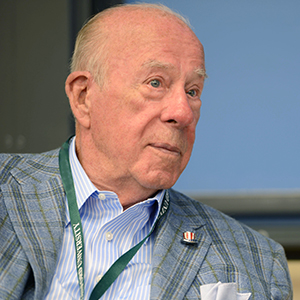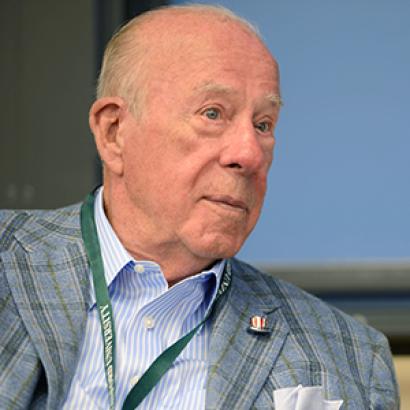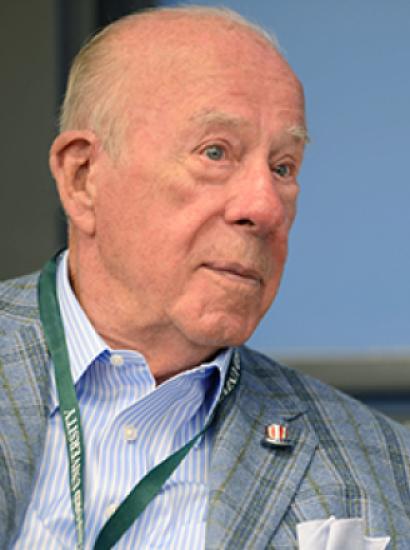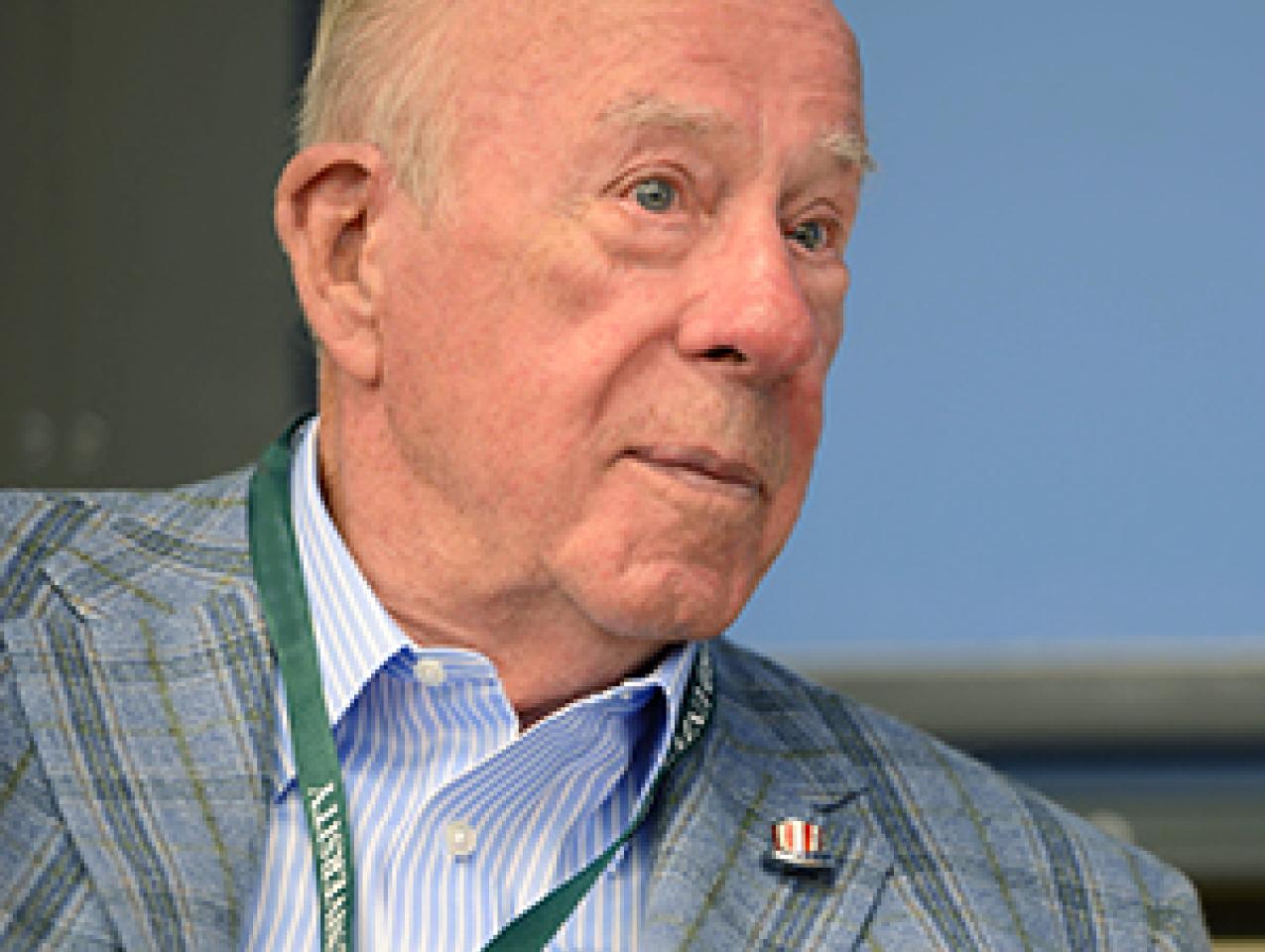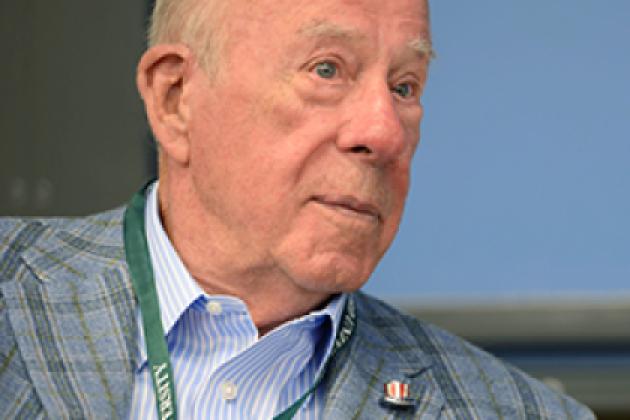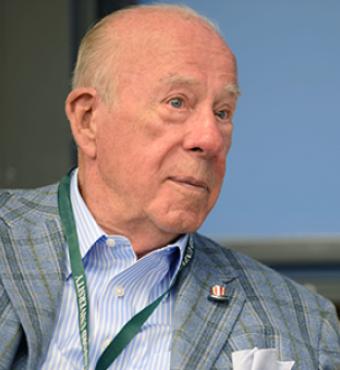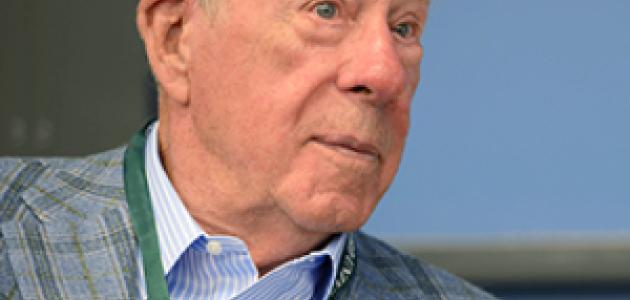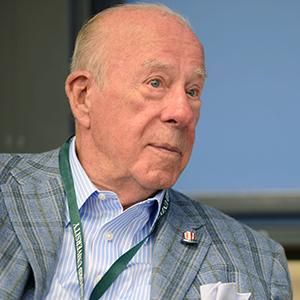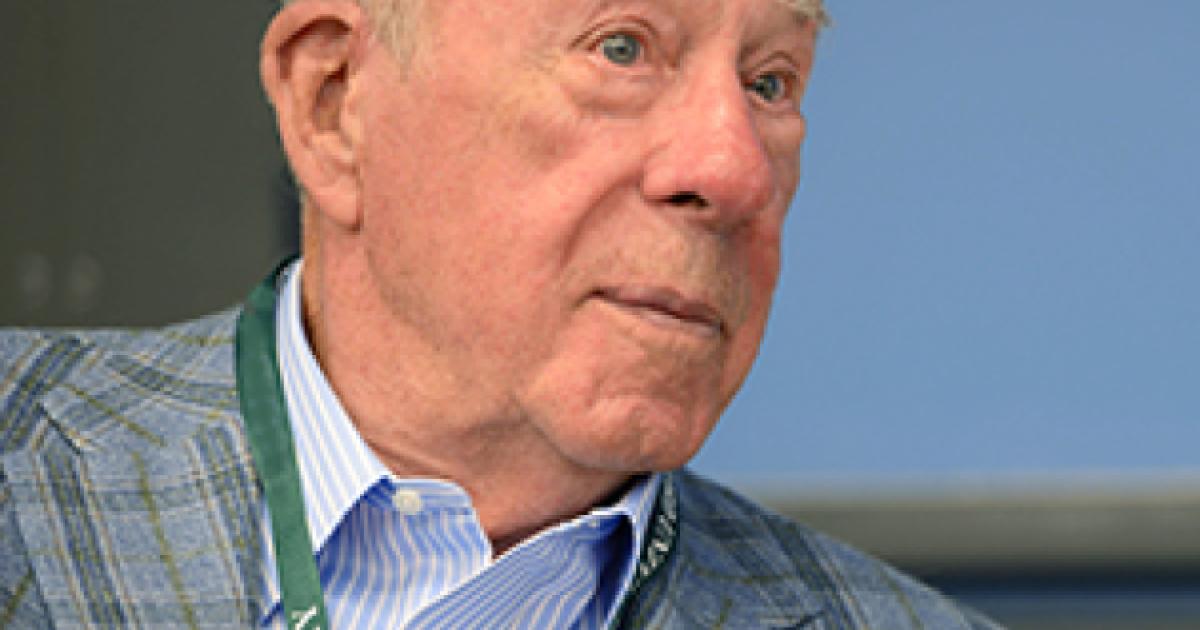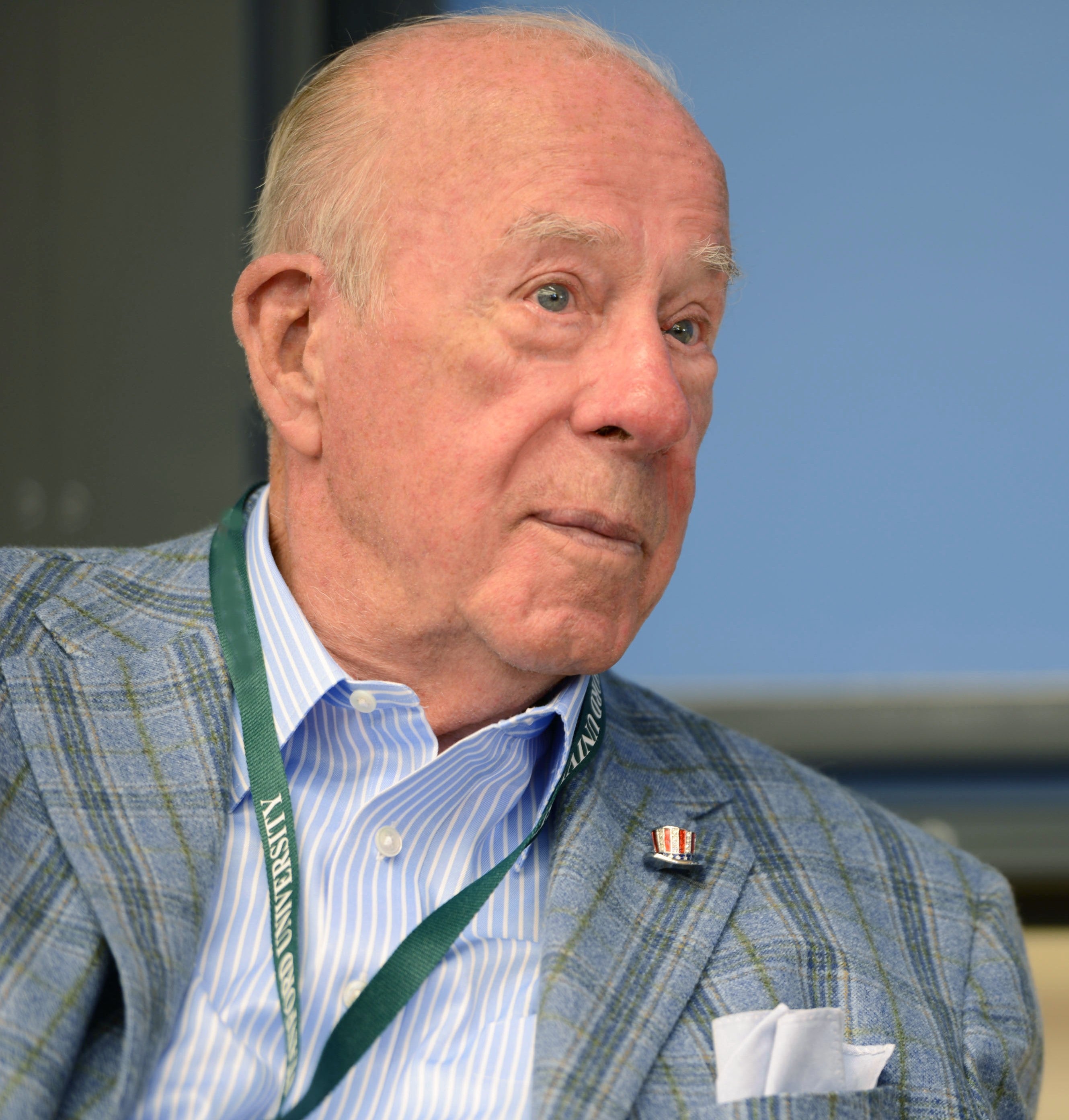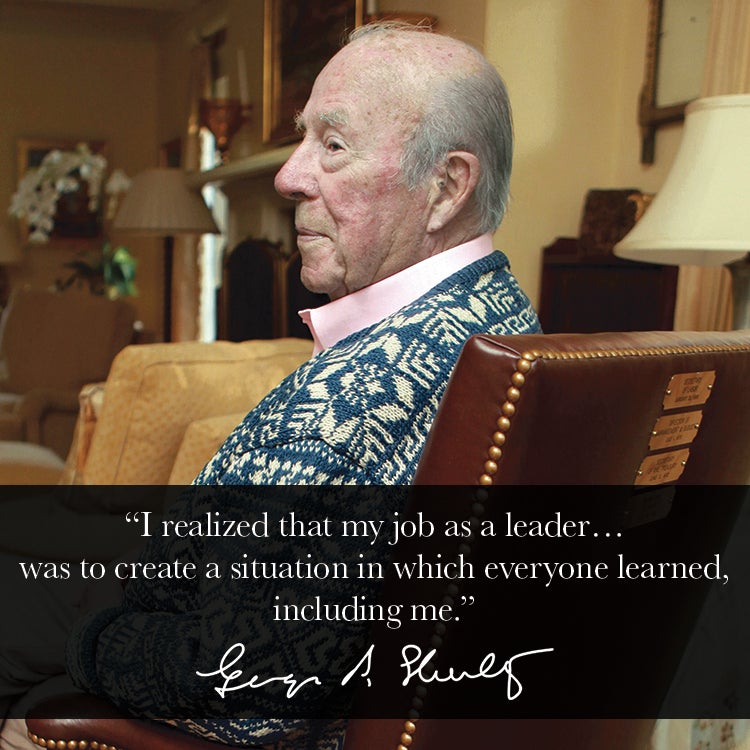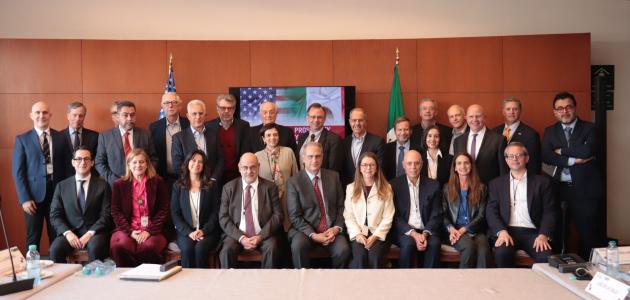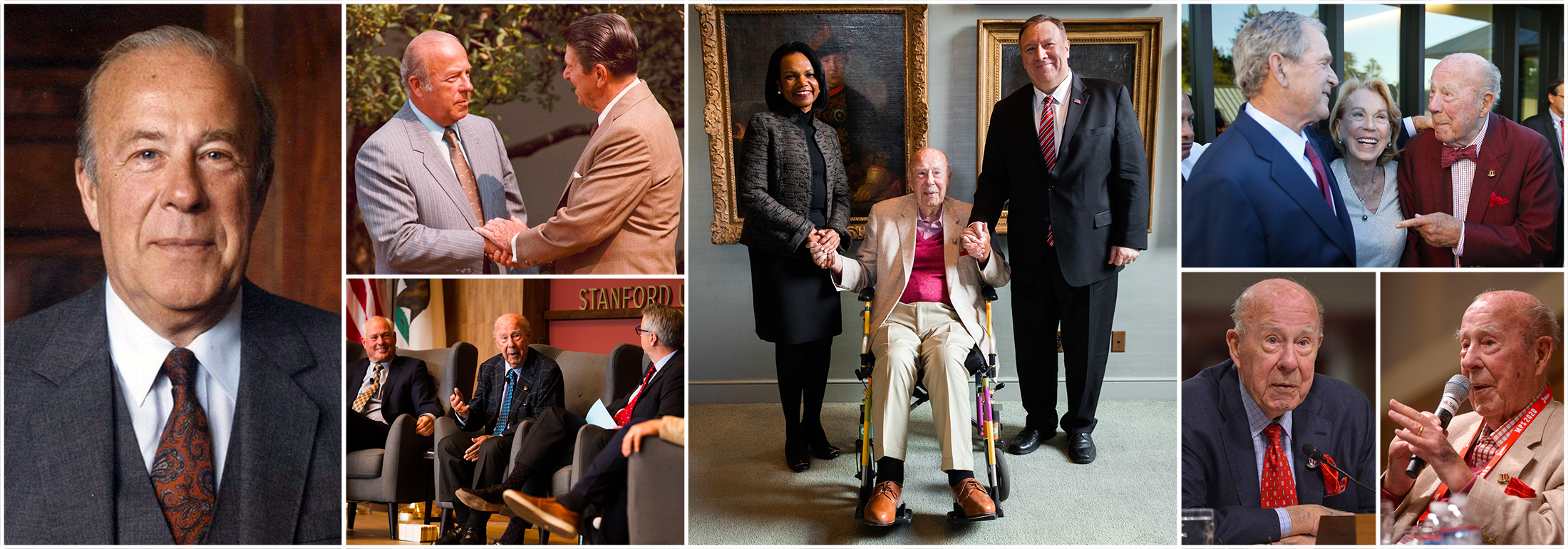
Hoover Institution (Stanford, CA) – George P. Shultz, Hoover Institution distinguished fellow, beloved colleague, accomplished diplomat and policy maker, and one of only two people in US history to serve four different presidential cabinet posts died February 6, 2021. He was 100.
In his career of more than thirty years at the Hoover Institution, Shultz was a prolific author of influential books about a wide breadth of public policy issues. His colleagues at Hoover called him the “great convener,” because he would assemble extraordinary minds to tackle the most difficult and vexing problems. He never shied away from trying to find answers to challenges.
Condoleezza Rice, a fellow former secretary of state and current director of the Hoover Institution, said, “Our colleague was a great American statesman and a true patriot in every sense of the word. He will be remembered in history as a man who made the world a better place.”
His most recent initiative at the Hoover Institution, Governance in an Emerging New World, revealed Shultz’s penchant for open discussions on how governments, institutions, and society can best respond to the world’s rapid changes. The initiative featured fourteen panel discussions in Hoover’s Hauck Auditorium, as well as a companion publication, A Hinge of History: Governance in an Emerging New World (Hoover Institution Press, 2020), offering informed strategies for the most serious global challenges to security, democracy, and economics posed by the century’s great transformative developments, from demographics to technology and the environment.
During the 2016 presidential election year, he led the publication of Blueprint for America, a compilation of ideas and strategies presented by Hoover fellows on how the United States can strengthen the foundation of its civic, economic, and security architecture and reclaim its mantle of global leadership.
This past year, in collaboration with Senior Fellow in Economics John B. Taylor, Shultz cowrote Choose Economic Freedom: Enduring Policy Lessons from the 1970s and 1980s. Part memoir and part plan of action, the book features Shultz’s recollections from the highest levels of policy making in the White House, specifically on how the free-market policies of the Reagan administration reversed the stagnation and hyperinflation of the 1970s.
George Pratt Shultz was born in New York City on December 13, 1920, and raised in Englewood, New Jersey. He attended Princeton University, where he majored in economics and wrote his senior thesis about the agricultural component of the New Deal’s Tennessee Valley Authority based on field work he conducted in the Volunteer State prior to his senior year.
After graduation in 1942, Shultz was commissioned as a first lieutenant in the United States Marine Corps just a year after America began engagement in the Second World War. He deployed to the South Pacific and was assigned as a marine liaison to an army unit during the 1944 invasion of Angaur Island, part of the small nation of Palau then occupied by Japan. Shultz said that after landing on the beachhead, the army dumped massive amounts of materiel, and confusion ensued as the battle erupted. Shultz appointed himself beachmaster and began dispatching the goods to the soldiers.
In 1946, Shultz married Helena Maria O’Brien, a military nurse he met while stationed in Hawaii. The two were married for nearly fifty years, until she passed away after a battle with cancer in 1995.
Following his World War II service, Shultz attended the Massachusetts Institute of Technology (MIT), where he earned his PhD specializing in industrial economics, and subsequently became an associate professor on the Cambridge, Massachusetts, campus. During this period of his early career, he participated in labor arbitration panels and took a sabbatical to serve as senior economist on President Dwight Eisenhower’s Council of Economic Advisers, from 1955 to 1957.
He left MIT to join the University of Chicago Business School in 1957 and assumed the role of dean in 1962. At Chicago, Shultz became acquainted with the free-market economist Milton Friedman, whose perspectives on economics and public policy left an indelible impression on Shultz. Friedman would remain a close confidant of Shultz during the Nixon and Reagan administrations, and much later when they both joined the Hoover Institution.
While continuing his work in Chicago, Shultz served as an informal adviser to presidents John F. Kennedy and Lyndon B. Johnson before being selected by President Richard Nixon to become US secretary of labor. He served a little over a year in the post, but his work had far-reaching impact.
Upon taking office, Nixon was faced with the strike of longshoremen on the Gulf Coast, into which Johnson previously intervened on grounds of national security. Shultz advised Nixon not to confer White House prestige on the negotiations and allow time to pressure the collective-bargaining process to resolution.
This period was also one of the most divisive times in American history. Among the major issues confronting national unity was the segregated landscape of the nation’s schools. Despite the landmark US Supreme Court decision Brown v. Board of Education, Topeka (1954), which effectively ended de jure segregation, most schools in the South still experienced a form of de facto segregation. In January 1969, 68 percent of Black children in the region attended all-Black schools.
Searching for a remedy, Nixon appointed Vice President Spiro Agnew and Shultz as the respective chair and vice chair of a cabinet committee with the objective of bringing into compliance seven southern states where segregation remained pervasive despite Brown and other court rulings.
Shultz stepped in as the principal leader after Agnew said he wanted no part of the effort. In addition to coordinating the committee’s proceedings, Shultz established biracial committees with White and Black leaders in the seven southern states. Shultz’s message was clear: the court’s orders to desegregate “with all deliberate speed” would be enforced. He would charge these local leaders with implementing the transition toward a unitary school system while preventing racial violence.
“The idea was to reach out to key leaders to persuade them to be part of the solution, not part of the problem,” Shultz said in a speech at the Nixon Library in 2003. “In the end, the school openings were peaceful, to the amazement of almost everyone.”
Prior to 1968, 186,000 of 3 million Black children in southern states sat in desegregated classrooms. Journalist James Rosen noted that by 1970, “the number edged closer to 3 million.”
As labor secretary, Shultz also negotiated and promoted hiring agreements between contractors and unions that established quotas for minority hiring in the White-dominated construction industry. Known as the “Philadelphia Plan,” the policy took effect in its namesake city in September 1969 and was thereafter adopted in many other cities across the United States.
Nixon appointed Shultz as the first director of the newly established Office of Management and Budget in summer 1970. Shultz participated in the August 1971 closed-door meeting of the president’s top economic advisors at Camp David, before Nixon shocked the nation in a televised address that he would be imposing wage and price controls and ending the convertibility of dollars to gold.
Shultz agreed with President Nixon’s judgment on closing the so-called gold window and allowing the dollar to be traded freely with other currencies at a flexible exchange rate. However, the president’s decisions on price controls and freezes, influenced largely by then Federal Reserve chairman Arthur Burns and Treasury secretary John Connally, contrasted with Shultz’s strong views against central government controls over economic matters.
“In the short term, the consumer price index, which measures inflation, declined and real GDP rose,” wrote Shultz and Taylor in Choose Economic Freedom. “But trouble lay ahead. The economy sputtered, and prices were a problem. . . . The gears of the economy ceased working in the normal and natural way that produces an efficient system.”
Shultz became secretary of the Treasury in June 1972, assuming more authority over the administration’s economic policy. According to historian Luke Nichter, Shultz’s appointment reflected a more diplomatic tone in international economic matters, especially among European leaders who had been unsettled by Connally’s brash style.
In May 1974, Shultz left the Nixon administration to become an executive at Bechtel Group, a major construction and engineering company based in San Francisco. Three years later he became the company’s president and CEO. While working in California’s Bay Area, Shultz became associated with Stanford University, where he lectured as an adjunct faculty member of the business school.
Following Ronald Reagan’s election to the presidency in 1980, Shultz assembled a group of the nation’s top economists and advised the president-elect on crafting an economic strategy that would set the course for the decade’s high rates of economic growth. Among other advice, the group’s strategy memo principally called for a reduction in individual tax rates, the removal of unnecessary and overburdensome regulations, and working with the Federal Reserve to implement a pro-growth and anti-inflationary monetary policy.
Reagan selected Shultz as the nation’s sixtieth secretary of state in the second year of the administration. This appointment was in many ways unorthodox, as Shultz’s career to this point largely centered on economic and labor matters. He also would be replacing Alexander Haig, a four-star general who had previously served as US commander at NATO, as Nixon’s White House chief of staff, and as second command at the National Security Council, under the inimitable Henry Kissinger.
Shultz said that his training as an economist was pivotal to his preparation for the job of America’s chief diplomat. “An economist is by training a strategist who will try to understand the constellation of forces present in a situation and try to arrange them to point toward a desirable result,” Shultz later wrote in his memoirs Turmoil and Triumph (1993). “A sense of strategy is critical in any negotiation: when to make concessions, when to hold firm, when to let things cool off, when to be intransigent.”
In March 1983, Shultz produced a detailed memorandum for President Reagan entitled “US-Soviet Relations: Where Do We Want to Be and How Do We Get There?” He advised the president to adopt as a minimum objective that the United States not permit Soviet geopolitical expansion in the Third World, and in the long term to make progress toward a stable and constructive US-Soviet relationship.
Shultz led efforts to forge a firm but flexible strategy that moved beyond the dueling philosophies of containment and détente, and toward a realistic policy of the United States pursuing its national interests without constraints. This strategy also included strengthening human rights, which Shultz strongly believed should not be left to the margins of international politics.
In his 2015 book The End of the Cold War: 1985–1991, Hoover Institution senior fellow Robert Service wrote that Shultz proved to be a “brilliant enabler” of Reagan in negotiations with the Soviet Union.
Prior to the first summit with Soviet general secretary Mikhail Gorbachev that took place in Geneva, Switzerland, in November 1985, Shultz advised Reagan to communicate to the Politburo that he had good intentions about limitations in nuclear arms. However, Shultz counseled the president to hold firm against giving up the United States’ Strategic Defense Initiative (SDI), a planned high-tech, satellite-based shield aimed to prevent attacks from Soviet intercontinental ballistic missiles. This point rattled Gorbachev and exposed a sense of vulnerability about the USSR in arms negotiations.
The first summit ended without an agreement but helped spur progress for future talks. Service maintained in his book that Shultz’s presence proved paramount. “Reagan sensed that the ice was cracking in global politics and wanted to strengthen his collaboration with Secretary Shultz. Together they were beginning to understand the USSR,” Service said. “Without the Secretary’s persistence, the President knew he would find it hard to achieve his purposes.”
Shultz was at Reagan’s side in October 1986 during the second US-Soviet summit in Reykjavik, Iceland. Two days of negotiations between Reagan and Gorbachev resulted in a draw, as the American president again refused to yield on giving up SDI as a condition for Russia’s dismantling of offensive weapons systems.
At the third US-Soviet summit in Washington in December 1987, Gorbachev dropped his demands to remove SDI and signed the Intermediate-Range Nuclear Forces (INF) Treaty, which eliminated an entire class of weapons in the European theater. Specifically, the treaty required each side to destroy within three years their ground-based ballistic and cruise missiles with ranges between 500 and 5,500 kilometers, as well as corresponding launchers and support structures.
Shultz said in an interview commemorating the Reykjavik summit’s thirtieth anniversary that the meeting was the first time the two countries placed elimination of all nuclear weapons on the agenda, and it thus paved the way for the INF Treaty. Today, nuclear arms have been reduced to one-third of what they were at the end of the Cold War. Working closely with former Secretary of Defense William Perry, Henry Kissinger, and former Senator Sam Nunn, Shultz devoted many years at Hoover seeking to reduce the threat of nuclear conflict.
Among his many other major foreign policy accomplishments, Shultz led resolution of conflict in the Middle East with the removal of Israeli troops from Lebanon, defused trade disputes with Japan, and negotiated the 1982 US-China Communiqué, which created a formula that allowed the United States to continue arms sales to Taiwan with pledges to respect the sovereignty of the People’s Republic of China.
Shultz is survived by his wife, Charlotte Mailliard Shultz, the former chief of protocol for the state of California, whom he married in 1997; his five children, Margaret Ann Tilsworth, Kathleen Pratt Shultz Jorgensen, Peter Milton Shultz, Barbara Lennox Shultz White, and Alexander George Shultz; eleven grandchildren; and nine great grandchildren.







